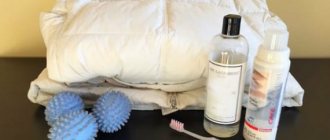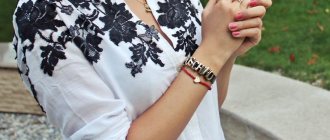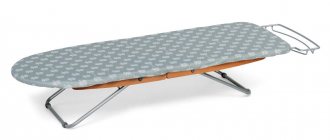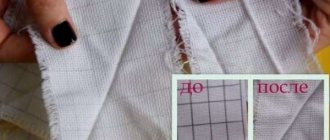Shirts have long won their place in the closet of both men and women. They are worn both on weekdays and on special occasions.
It is important that the item not only fits in size and style, but also looks great. Otherwise, the reputation of its owner may suffer greatly - no one will want to deal with an unkempt person in a wrinkled, unwashed shirt.
In order for this wardrobe item to retain its appearance and color for a long time, it is necessary to take proper care of it. After all, improper washing of a product can simply ruin it, and to prevent this from happening, you need to know how to wash a white and colored shirt.
Acceptable types of washing shirts made from different fabrics
Shirts are made from different fabrics from here and the question arises - how to properly care for them so that they do not lose their shape and color.
Can a cotton shirt be machine washed? Yes, you can. For this type of fabric, both automatic and hand washing are acceptable. However, the product may lose a little in size, by about 5%, and nothing can be done about it.
For silk shirts, hand wash only and without pre-soaking is provided. Temperature: no more than 30 °C.
A wool shirt is less finicky - it can be washed in a washing machine or by hand. However, the machine must have a washing mode for products made from this type of fabric. A woolen shirt should not be wrung out too much.
Things are no simpler with shirts made from artificial materials. If we are talking about viscose, for example, then it is better to wash by hand and only in cool water, otherwise expect the fabric to shrink by about 7%.
But if the product is synthetic, for example, elastane or lycra, you can safely put the item in the washing machine and wash it at 40 °C.
It is important to use the appropriate detergent for each type of fabric.
For cotton shirts, any powder is suitable; silk and wool can only be washed with special detergents, and for artificial and synthetic shirts, use soft detergents.
Types of pollution
Pollution has its own varieties, therefore, depending on the origin of the stain, several types are distinguished.
White shirts get dirty quickly. There are several types of stains, which are classified by origin. According to this differentiation, the following types of pollution are distinguished:
- Oily spots. They appear due to the penetration of oils of plant or animal origin, as well as wax, into the fibers. They are distinguished by slight darkening with a blurred border. If such contamination is not removed in time, it will turn into a matte area on the product.
- Bold spots. Formed when soup, sauce or milk gets on clothes. The grease is absorbed into the fabric and the residue turns into a stain. The color of the dirt varies, as blood is included in this category.
- Stains from fruits and vegetables. The outline is clear and the color is bright. Penetrating into the fibers, they change color to yellow or pale brown.
- Contamination from technical fluids. Such stains are not only strongly absorbed into the fabric and difficult to remove, but are also characterized by a sharp, specific odor.
Preparing for washing
Before you start washing men's shirts, you need to prepare them. The first thing to do is sort things by color.
After all, white and colored linen are washed separately. A white shirt may become stained by a colored item and be ruined.
It is also necessary to carefully study the label of the shirt, because not all items can be washed in a machine.
If there are no restrictions, then you should look for complex stains and treat them manually, for example, with a stain remover.
Remember, a washing machine may not be able to handle serious stains on its own.
Then you need to fasten all the buttons on the shirt. This simple procedure allows you to avoid unnecessary deformation of items during washing.
And of course, don’t forget to look in your pockets, in case there is money, a card or other small items lying around. If you find trash, shake it out.
Pre-soak
It is safer to soak the shirt before washing. After all, this procedure will help to cope with the most difficult stains on the collar, cuffs and armpits.
By the way, some washing machines have a “soak” mode and it’s easier to use it. If there is no such regime, then feel free to take a basin and detergent.
You need to dilute soap shavings or powder in hot water, then immerse the product in water. In this case, wash the contaminated areas (collar, etc.) separately with laundry soap, after moistening them with water.
After about an hour, the shirt can be washed. By the way, a solution of salt and ammonia will also help fight complex stains. You just need to add a few drops to the water.
Linen clothing
Linen is easy to bleach.
It is suggested to use one of the following methods:
- To get rid of gray plaque, it is recommended to add 2 tbsp when washing. l. salt.
- To lighten, soak linen shirts and blouses in soda water. Mix 0.5 kg of soda in 5 liters of liquid. Before use, soak the solution for 24 hours and strain. This product can be stored in a glass container for a long time.
- Turpentine will help make the fabric snow-white. For 1 liter of water add 1 tbsp. l. substances. Soak things for at least 10-12 hours.
- Yellowness can be eliminated with ammonia diluted in water. To do this, add 1 tbsp to a liter of liquid. alcohol
- The last method is vinegar 9%. Pour 100 ml of vinegar into 2 liters. Soak the laundry for 3 hours and wash.
Read more ► How to whiten white clothes with aspirin at home
How to wash shirts in a washing machine
Washing shirts seems to be a common task only at first glance, but if you look at it, it turns out that this process requires certain instructions:
- It is necessary to observe the temperature regime. Unless, of course, you want to damage the material of the product. The optimal temperature for shirt fabric is usually indicated on the label, but it should still not exceed 40°C.
- If you don't know what temperature setting will suit your shirt, choose a "delicate wash".
- For colored and dark items, liquid powder is better. Use this instead of regular powder, as liquid powder washes out better.
- It is better to wring shirts by hand; machine wringing can deform them. At the same time, try not to twist things too much, otherwise they may lose their appearance and stretch.
- Shirts should be dried as far as possible from heating appliances. And if you put them on hangers, then after drying they will be easier to iron.
Lightening of synthetics
Synthetic fabrics are one of the most delicate materials.
Use the following tools:
- Aspirin . For 1 shirt you need to take 2-3 tablets. Grind to a powder. Rub into damp cloth. Wash after achieving the desired result.
- Potato . Peel the tuber, cut in half. Rub the desired areas well. Wait until completely dry. Get rid of remaining starch with a brush. After such treatment, wash items in the standard way.
How to wash a shirt by hand
Washing a shirt by hand is the most gentle option for cleaning the fabric of the product. This method will significantly extend the life of things.
In order to wash a shirt by hand, you need to know a certain procedure:
- You need to fill a basin with warm water and dissolve 2-3 tablespoons of washing powder or liquid detergent in it.
- Immerse the shirt in water and leave it in the solution for half an hour.
- If there are stains on things, you need to rub them with laundry soap.
- Half an hour after soaking, the dirty water should be drained, the shirt should be rinsed in clean water, then the water should be drawn again and the shirt should be washed by hand. Contaminated areas can be gently scrubbed with a soft-bristled brush.
- If the shirt is light and the stains are not completely washed off, you can add chlorine-free bleach to the water and wait a while.
- Now the item can be rinsed thoroughly.
Additional folk remedies
Aspirin
Aspirin solution perfectly cleans collars. To do this, dissolve 3-5 aspirin tablets in a glass of warm water. Soak clothes for 3-5 hours in this solution and then wash.
Talc
At night, you can sprinkle the moistened collar with talcum powder, and put off washing until the morning. Baby powder can also be an analogue.
Raw potatoes
Peel the raw potato and cut in half. Carefully rub the cut area on the problem areas of the collar so that the fabric is saturated with potato juice. After this, you need to take a sponge with detergent and thoroughly soap the collar, and then wash it with detergent.
For more juice, peeled potatoes can be grated. Let the mixture stand for 5 minutes until the juice releases. Squeeze through a clean cloth. Pour the juice over the stain. Wait half an hour. Hand wash in soapy water.
How to wash a white shirt
White fabric is the most problematic to wear and care for. For light-colored items, hand washing is better, and shirts are no exception in this regard.
Especially if the item was worn for several days without washing, which, by the way, is not advisable to do. It is better to wash white things after each wear and follow certain rules; if you neglect them, the shirt will acquire a grayish tint and also lose its shape.
Another possible problem is that various stains may remain on the shirt. Therefore, you first need to soak the white item, treating it with special anti-stain products, and then wash the white shirt.
The methods for removing stains for white items are similar to the options for any colored or dark items, and we will write about them later.
It is important to remember that:
- Light-colored items should always be washed separately from colored items. This will protect the white fabric from staining.
- Even a small colored insert on a white shirt can ruin the color of the item. Therefore, it is better to wash such a shirt by hand first to check how the colored part of the product behaves. If nothing happens, then such a shirt can be washed with other white things.
- For light-colored items, a temperature of no higher than 30 degrees is needed.
Tips and prohibitions
In order for white items to last as long as possible and not lose their original appearance, it is recommended to follow a number of rules:
- It is preferable to wash linen products by hand using detergents without chlorine;
- When rinsing, do not spare water;
- do not load too many things into the machine drum at the same time so that there is enough free space there;
- It is advisable to dry white shirts in the fresh air, but not under direct exposure to sunlight;
- when machine washing, choose delicate or manual mode to protect the fabric from damage;
- viscose and silk products are washed without spinning, synthetic ones - with spinning at 800 rpm.
How to dry a shirt quickly
It is not advisable to dry the shirt in the washing machine, as this can deform the collar and cuffs.
It is better to dry the shirt on hangers, having previously wrung it out after washing. Don't forget to straighten out the sleeves and any folds.
Drying under natural conditions will prevent the product from spoiling its shape. Moreover, on a windy, sunny day, clothes can be dried very quickly outside.
Before drying, the item must be turned inside out so that it does not fade in the sun.
Another quick way is ironing. Heat up the iron by turning off its steam function. Then iron the wet shirt on both sides (it is advisable to iron the front one through gauze). After ironing, you can place the shirt on a chair for 10 minutes and then repeat ironing.
Fighting yellow spots
Yellow spots usually appear in the collar area, and there are several ways to get rid of them:
- Hydrogen peroxide and liquid soap. Take 4 tablespoons of soap and mix with 50 ml of peroxide. The product is ready, now you can treat the most contaminated areas with this composition. Then leave the item in the solution for 40 minutes and you can start washing.
- Use stain remover. It is advisable that it be a chlorine-free bleach, as chlorine destroys fabric. This method is also good in combating complex stains. You need to apply a little product to the stain (it is sold at any hardware store), wait 20 minutes and then wash the shirt.
- Toothpaste works well on stains. It must be applied to the desired places, gently rubbed into the material and after 15 minutes you can wash the item.
Important! For a white shirt, you can only use white toothpaste; colored additives can ruin the material.
Household bleaches
Not everyone wants to resort to traditional methods of removing yellowness, grease stains and dirt in order to save white things. It's easier to use chemical compounds.
There is a division into chlorine-containing and oxygen-containing agents:
| Substances | pros | Minuses | Examples |
| Chlorine-containing | Quick results | Aggressive, corrode matter | "Chlorine" |
| Small quantity to use | Acrid odor, can burn mucous membranes | "White" | |
| Acceptable price | Hand and face protection required | "Domestos" | |
| Not suitable for thin materials and underwear | |||
| Oxygen | Hypoallergenic | The result is not always at a high level | "Vanish" |
| Can bleach delicate fabrics, underwear | Expensive | "Ecover" | |
| Suitable for all types of material |
Need to know! A new type of brightener has appeared - optical liquid. It visually removes dirt, the effect lasts up to 8 hours, which is enough for a working day. An example of a product is Belotex.











